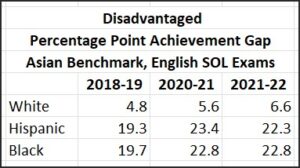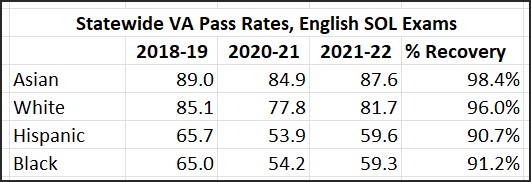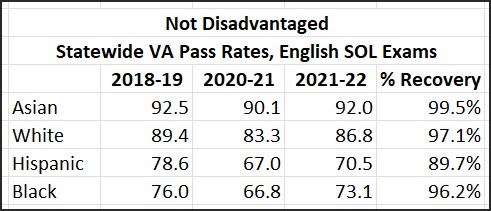by James A. Bacon
Two weeks ago, before I so rudely interrupted myself by taking a vacation in North Carolina, I was engaged in an analysis of the latest Standards of Learning (SOL) test scores. As measured by pass rates, Virginia students statewide recovered much, but not all, of the ground they had lost during the disastrous 2020-21 school year of COVID-driven school closures. However, I showed there was considerable variability between school districts. Some some districts rebounded so smartly that pass rates last year (2021-22) exceeded those of the pre-COVID year of 2018-19. Others showed minimal recovery.
Today, I’ll drill into the data to examine the role of economic disadvantage and race. Rather than explore the “Black/White” divide in scores, as is customary among those who wish to perpetuate the idea of “systemic racism,” I present data using Asians as the benchmark of performance, compared to whom all other groups — Whites, Blacks, and Hispanics most prominently — fall short.
In the table above we can see that 87.6% of students classified as Asian passed their English SOL tests last year, bringing them back to 98.4% of the pre-COVID norm. Whites recovered to a lesser degree, and Hispanics and Blacks an even lesser degree. Comparing the post-COVID year with the pre-COVID year, the racial achievement gap got worse.
It is widely accepted that the shift from in-person to hybrid and remote learning during the height of the COVID pandemic in 2020-21 is largely to blame for the plunge in pass rates across all districts, racial/ethnic groups and socioeconomic classes. However, the variability in performance after everyone returned to school is harder to explain.
It is common wisdom that economically disadvantaged students had the toughest time during the pandemic. They were less likely to have access to laptops and the Internet, and parents were less able to rearrange their lives to spend time at home and supervise their activity. As can be seen in the table below, the decline in SOL pass rates among non-economically disadvantaged students (with family incomes too high to qualify for free and subsidized lunches) were modest during the pandemic year, and have come close to passing at the same rate as in the pre-pandemic year.
The outliers among non-disadvantaged students are the non-disadvantaged Hispanic students. They dropped the most during the pandemic year, and they have recovered the least. There is something distinctive about non-disadvantaged Hispanics — perhaps their higher likelihood to be English language learners — that calls out for explanation. It is worth a follow-up look at the statistics.
The table below shows the English SOL pass rates for economically disadvantaged students broken down by race/ethnicity.
Pass rates declined significantly among all race/ethnicities — much more than for the non-disadvantaged students. That seems to confirm the idea that socio-economic status was a major factor in declining pass rates — poor households were less able to adapt to the challenges of remote learning than well-to-do households.
But race/ethnicity is also a factor. Remember, all the students in this table are economically disadvantaged. Pass rates during the pandemic year dropped by 9 to 12 percentage points for all groups, but Asians have rebounded significantly more than Whites, who in turn recovered more than Hispanics and Blacks. In other words, socioeconomic status goes only so far in explaining last year’s SOL results.
One possible explanation would blame systemic racism. From curricula to behavioral expectations, according to the woke school of thought, the educational system was designed by Whites for Whites. Proponents of this explanation have to explain, however, why Asians consistently out-perform Whites in a system supposedly dominated by Whiteness. Labeling Asians “White adjacent” is not an explanation. Another weakness is that, while this explanation conceivably explains the differences in pre-pandemic pass rates, it cannot explain why the post-pandemic rebound has been slower for Blacks and Hispanics. The past three or four years have seen the widespread implementation of “anti-racist” policies at every level. If structural racism were the problem, Blacks and Hispanics should be catching up. They’re not. The gap is getting wider.
The following tables show the racial gaps in SOL pass rates (using Asians as the benchmark) for economically advantaged and disadvantaged students.


The gap between Asians on the one hand and Whites, Hispanics and Blacks on the other hand widened for both advantaged and disadvantaged alike.
Alternate explanations of this divergence are called for. One approach would be to focus on how well different school districts managed the challenges of the COVID shutdown and its aftermath. Perhaps some school districts are more politically dysfunctional than others. Perhaps some have superior philosophies.
As time permits, I will explore that topic in future posts.




Leave a Reply
You must be logged in to post a comment.